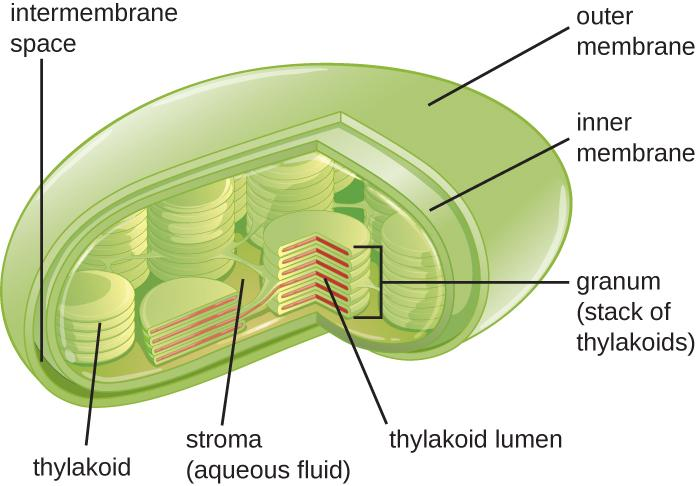
The internal system of interconnected membrane-limited sacs of chloroplasts are
A. Grana
B. Stroma
C. Thylakoids
D. Cisternae
Answer
580.5k+ views
Hint: A chloroplast is a type of organelle known as a plastid, characterized by its two membranes and a high concentration of chlorophyll. Other plastid types, such as the leucoplast and the chromoplast, contain little chlorophyll and do not carry out photosynthesis.
Complete answer: Chloroplasts also contain an extensive internal system of interconnected membrane-limited sacs called thylakoids, which are flattened to form disks; these often are grouped in stacks called grana and embedded in a matrix.
1. The thylakoid membranes contain green pigments (chlorophylls) and other pigments and enzymes that absorb light and generate ATP during photosynthesis.
2. Part of this ATP is used by enzymes located in the stroma to convert CO$_2$ into three-carbon intermediates; these are then exported to the cytosol and converted to sugars.
3. Thylakoids are membrane-bound compartments inside chloroplasts and cyanobacteria.
4. They are the site of the light-dependent reactions of photosynthesis.
5. Thylakoids consist of a thylakoid membrane surrounding a thylakoid lumen. Chloroplast thylakoids frequently form stacks of disks referred to as grana.

6. Grana are connected by intergranal/ stroma thylakoids, which join granum stacks together as a single functional compartment.
7. In higher plants, thylakoids are organized into a granum-stroma membrane assembly. A granum (plural grana) is a stack of thylakoid discs.
8. Chloroplasts can have from 10 to 100 grana. Grana are connected by stroma thylakoids, also called intergranal thylakoids or lamellae.
Additional information: Chloroplasts are highly dynamic—they circulate and are moved around within plant cells, and occasionally pinch in two to reproduce.
Their behavior is strongly influenced by environmental factors like light color and intensity.
Chloroplasts, like mitochondria, contain their own DNA, which is thought to be inherited from their ancestor—a photosynthetic cyanobacterium that was engulfed by an early eukaryotic cell.
Chloroplasts cannot be made by the plant cell and must be inherited by each daughter cell during cell division.
So the correct answer is Thylakoids
Note: Thylakoids are the internal membranes of chloroplasts and cyanobacteria and provide the platform for the light reactions of photosynthesis. Chloroplasts of land plants contain grana, characteristic cylindrical stacks of membrane discs with a typical diameter of 400nm that comprise ~5–20 layers of the thylakoid membrane.
Complete answer: Chloroplasts also contain an extensive internal system of interconnected membrane-limited sacs called thylakoids, which are flattened to form disks; these often are grouped in stacks called grana and embedded in a matrix.
1. The thylakoid membranes contain green pigments (chlorophylls) and other pigments and enzymes that absorb light and generate ATP during photosynthesis.
2. Part of this ATP is used by enzymes located in the stroma to convert CO$_2$ into three-carbon intermediates; these are then exported to the cytosol and converted to sugars.
3. Thylakoids are membrane-bound compartments inside chloroplasts and cyanobacteria.
4. They are the site of the light-dependent reactions of photosynthesis.
5. Thylakoids consist of a thylakoid membrane surrounding a thylakoid lumen. Chloroplast thylakoids frequently form stacks of disks referred to as grana.

6. Grana are connected by intergranal/ stroma thylakoids, which join granum stacks together as a single functional compartment.
7. In higher plants, thylakoids are organized into a granum-stroma membrane assembly. A granum (plural grana) is a stack of thylakoid discs.
8. Chloroplasts can have from 10 to 100 grana. Grana are connected by stroma thylakoids, also called intergranal thylakoids or lamellae.
Additional information: Chloroplasts are highly dynamic—they circulate and are moved around within plant cells, and occasionally pinch in two to reproduce.
Their behavior is strongly influenced by environmental factors like light color and intensity.
Chloroplasts, like mitochondria, contain their own DNA, which is thought to be inherited from their ancestor—a photosynthetic cyanobacterium that was engulfed by an early eukaryotic cell.
Chloroplasts cannot be made by the plant cell and must be inherited by each daughter cell during cell division.
So the correct answer is Thylakoids
Note: Thylakoids are the internal membranes of chloroplasts and cyanobacteria and provide the platform for the light reactions of photosynthesis. Chloroplasts of land plants contain grana, characteristic cylindrical stacks of membrane discs with a typical diameter of 400nm that comprise ~5–20 layers of the thylakoid membrane.
Recently Updated Pages
Master Class 12 Business Studies: Engaging Questions & Answers for Success

Master Class 12 Economics: Engaging Questions & Answers for Success

Master Class 12 English: Engaging Questions & Answers for Success

Master Class 12 Maths: Engaging Questions & Answers for Success

Master Class 12 Social Science: Engaging Questions & Answers for Success

Master Class 12 Chemistry: Engaging Questions & Answers for Success

Trending doubts
What are the major means of transport Explain each class 12 social science CBSE

Which are the Top 10 Largest Countries of the World?

Draw a labelled sketch of the human eye class 12 physics CBSE

Explain sex determination in humans with line diag class 12 biology CBSE

The pH of the pancreatic juice is A 64 B 86 C 120 D class 12 biology CBSE

Explain sex determination in humans with the help of class 12 biology CBSE




